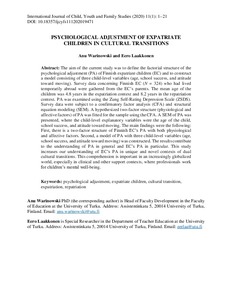Psychological Adjustment of Expatriate Children in Cultural Transitions
Eero Laakkonen; Anu Warinowski
Psychological Adjustment of Expatriate Children in Cultural Transitions
Eero Laakkonen
Anu Warinowski
UNIV VICTORIA, SCH CHILD & YOUTH CARE
Julkaisun pysyvä osoite on:
https://urn.fi/URN:NBN:fi-fe2021042823629
https://urn.fi/URN:NBN:fi-fe2021042823629
Tiivistelmä
The aim of the current study was to define the factorial structure of the psychological adjustment (PA) of Finnish expatriate children (EC) and to construct a model consisting of three child-level variables (age, school success, and attitude toward moving). Survey data concerning Finnish EC (N = 324) who had lived temporarily abroad were gathered from the EC's parents. The mean age of the children was 4.8 years in the expatriation context and 8.2 years in the repatriation context. PA was examined using the Zung Self-Rating Depression Scale (ZSDS). Survey data were subject to a confirmatory factor analysis (CFA) and structural equation modeling (SEM). A hypothesized two-factor structure (physiological and affective factors) of PA was fitted for the sample using the CFA. A SEM of PA was presented, where the child-level explanatory variables were the age of the child, school success, and attitude toward moving. The main findings were the following: First, there is a two-factor structure of Finnish EC's PA with both physiological and affective factors. Second, a model of PA with three child-level variables (age, school success, and attitude toward moving) was constructed. The results contribute to the understanding of PA in general and EC's PA in particular. This study increases our understanding of EC's PA in unique and novel contexts of dual cultural transitions. This comprehension is important in an increasingly globalized world, especially in clinical and other support contexts, where professionals work for children's mental well-being.
Kokoelmat
- Rinnakkaistallenteet [19248]
